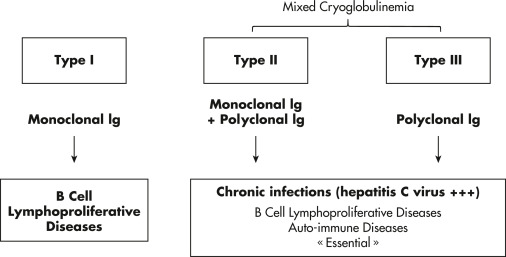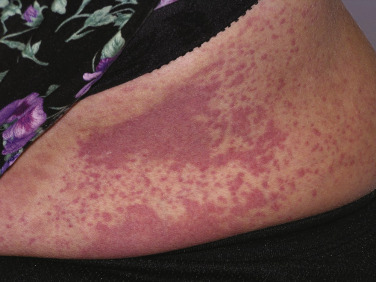AUTHOR: Rebecca Soinski, MD
Cryoglobulins are serum immunoglobulins that precipitate when cooled and redissolve when heated. A classification of cryoglobulins is described in Table E1 and Fig. E1. Cryoglobulinemia is a clinical syndrome that re-sults from systemic inflammation caused by cryoglobulin-containing immune complexes. Mixed cryoglobulinemia is a vasculitis of small and medium-sized arteries and veins due to the deposition of complexes of antigen, cryoglobulin, and complement in the vessel walls.1
Figure E1 Cryoglobulin immunotyping and related underlying diseases. Ig, Immunoglobulin.

From Cacoub P et al: Cryoglobulinemia vasculitis, Am J Med 128[9]:950-955, 2015.
TABLE E1 Classification of Cryoglobulins
| Type | Composition | Associated Disease |
|---|---|---|
| I | Monoclonal IgG, IgA, or IgM | Multiple myeloma (IgG, IgM)Chronic lymphocytic leukemiaWaldenström macroglobulinemiaIdiopathic monoclonal gammopathyLymphoproliferative disorders |
| II | Polyclonal IgG and monoclonal IgM (with rheumatoid factor activity) | Hepatitis C, hepatitis B, HIV neoplasms: Chronic lymphocytic leukemia, diffuse lymphoma, B lymphocytic neoplasia |
| III | Polyclonal IgG and polyclonal IgM | Infections: Viral (hepatitis B and C, Epstein-Barr virus, cytomegalovirus), bacterial (endocarditis, leprosy, poststreptococcal glomerulonephritis), parasitic (schistosomiasis, toxoplasmosis, malaria)Autoimmune disorders: Systemic lupus erythematosus, rheumatoid arthritisLymphoproliferative disordersChronic liver disease |
HIV, Human immunodeficiency virus; Ig, immunoglobulin.
From Floege J et al: Comprehensive clinical nephrology, ed 4, Philadelphia, 2010, Saunders.
- Prevalence of mixed cryoglobulinemia is approximately 1:100,000. With the success of direct acting antivirals for treatment of HCV, incidence of mixed cryoglobulinemia has steadily decreased.1
- In the 1990s, 90% of cryoglobulinemic patients were found to have HCV; approximately 25% to 30% of patients with HCV were found to have mixed cryoglobulinemia1 with only 5% to 10% developing vasculitis.2
- Three types: I (monoclonal), II (IgM monoclonal and IgG polyclonal), and III (polyclonal).3
- Meltzer triad of purpura, arthralgias/myalgia, and weakness is seen in one third of patients.4
- Other symptoms include fatigue, peripheral neuropathy, Raynaud’s phenomenon, renal involvement, sicca syndrome, confluent purpura (Fig. E2), and skin ulcers.2
- Hypertension, hepatosplenomegaly, and in severe cases, distal necrosis and ulcerations of lower limbs (Fig. E3).
- Intravascular deposition of cryoglobulins leading to ischemic insults in territory supplied by vasa nervorum
- Necrotizing vasculitis caused by cryoglobulin precipitation in cooler areas (distal extremities) and kidneys (increased concentration due to ultrafiltration)3
- Infections: HCV, mycosis fungoides, HBV, HIV, Epstein-Barr virus, cytomegalovirus, Treponema pallidum, Mycobacterium leprae, and in post-streptococcal glomeru-lonephritis
- Lymphoproliferative disorders: Chronic lymphocytic leukemia, Waldenström macroglobulinemia, multiple myeloma4
- Connective tissue disorders: Rheumatoid arthritis, systemic lupus erythematosus (SLE), scleroderma, Sjögren syndrome, vasculitis4
- Renal diseases including proliferative glomerulonephritis4



